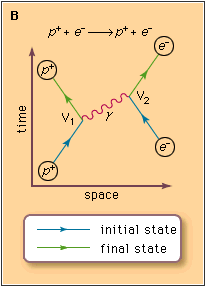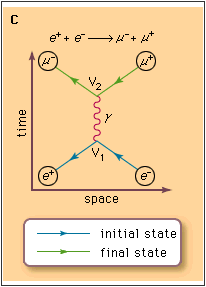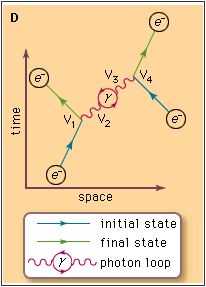
You are here: Home >> History of Light >> New Ideas >> Feynman Diagrams
 Feynman used to be one of the most attractive personalities in history of Physics. He shared the 1965 Nobel Prize in physics for his role in the development of the theory of quantum electrodynamics.
Feynman used to be one of the most attractive personalities in history of Physics. He shared the 1965 Nobel Prize in physics for his role in the development of the theory of quantum electrodynamics.
Feynman diagrams constitute a graphic method of representing the interactions of elementary particles, invented by him. He introduced the diagrams as an aid to calculating the processes that occur between electrons and photons, in the course of his development of quantum electrodynamics. Feynman diagrams are now used to depict all types of particle interaction. In a Feynman diagram, one axis, for example the horizontal axis, is chosen to represent space, while the other represents time. Straight lines are used to depict fermions-particles with half-integral values of intrinsic angular momentum (spin), such as electrons (e-); and wavy lines are used for bosons-particles with integral values of spin, such as photons (γ).
 At the quantum level, the interactions of fermions occur through the emission and absorption of the field particles associated with the fundamental forces, in particular the electromagnetic force, the strong force, and the weak force. These field particles are all bosons. The basic interaction therefore appears on a Feynman diagram as a "vertex"-i.e., a junction of three lines. In this way, the path of an electron, for example, appears as two straight lines connected to a third, wavy line where the electron emits or absorbs a photon (First figure).
At the quantum level, the interactions of fermions occur through the emission and absorption of the field particles associated with the fundamental forces, in particular the electromagnetic force, the strong force, and the weak force. These field particles are all bosons. The basic interaction therefore appears on a Feynman diagram as a "vertex"-i.e., a junction of three lines. In this way, the path of an electron, for example, appears as two straight lines connected to a third, wavy line where the electron emits or absorbs a photon (First figure).
The calculation for a particular process in quantum electrodynamics must include terms equivalent to all lines (propagating particles) and all vertices (interactions) in the associated Feynman diagrams. In such calculations, the procedure is to write down every possible diagram so as to include its contribution to the total probability for the particular process to occur.
The simplest diagrams involve only two vertices, representing the emission and absorption of a field particle. (Second figure) In this diagram, a proton (p+) emits a photon at V1, and this photon is then absorbed at some slightly later time by an electron at V2.  The emission of the photon causes the proton to recoil in space, while the absorption of the photon's energy and momentum by the electron causes a comparable deflection in the electron's path. The result of this interaction is for both particles to move away from each other in space.
The emission of the photon causes the proton to recoil in space, while the absorption of the photon's energy and momentum by the electron causes a comparable deflection in the electron's path. The result of this interaction is for both particles to move away from each other in space.
 One intriguing feature of Feynman diagrams is that antiparticles are represented as normal particles moving backward in time. (Third figure) an electron collides with its antiparticle, the positron (e+), and both are annihilated. A photon is emitted by the collision, and it decays into two new particles in space: a muon (μ-) and its antiparticle, an antimuon (μ+). In the diagram, both antiparticles (e+, μ+) are moving toward the past, while their corresponding particles (e-, μ-) are moving toward the future.
One intriguing feature of Feynman diagrams is that antiparticles are represented as normal particles moving backward in time. (Third figure) an electron collides with its antiparticle, the positron (e+), and both are annihilated. A photon is emitted by the collision, and it decays into two new particles in space: a muon (μ-) and its antiparticle, an antimuon (μ+). In the diagram, both antiparticles (e+, μ+) are moving toward the past, while their corresponding particles (e-, μ-) are moving toward the future.
More complex Feynman diagrams, involving the emission and absorption of many particles, are also possible. (Forth figure) In this diagram, two electrons exchange two separate photons, producing four different interactions at V1, V2,V3, and V4, respectively.